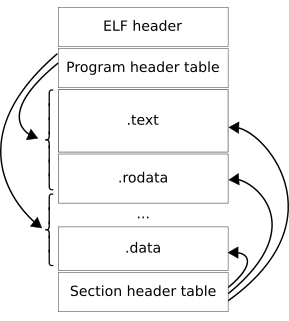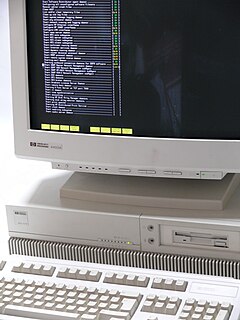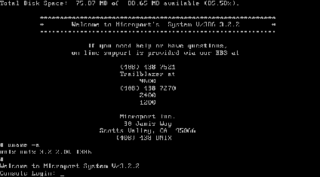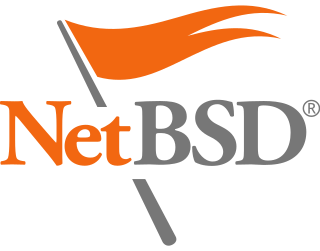Related Research Articles

AIX, is a series of proprietary Unix operating systems developed and sold by IBM for several of its computer platforms. Originally released for the IBM RT PC RISC workstation, AIX now supports or has supported a wide variety of hardware platforms, including the IBM RS/6000 series and later POWER and PowerPC-based systems, IBM System i, System/370 mainframes, PS/2 personal computers, and the Apple Network Server.

In computing, the Executable and Linkable Format, is a common standard file format for executable files, object code, shared libraries, and core dumps. First published in the specification for the application binary interface (ABI) of the Unix operating system version named System V Release 4 (SVR4), and later in the Tool Interface Standard, it was quickly accepted among different vendors of Unix systems. In 1999, it was chosen as the standard binary file format for Unix and Unix-like systems on x86 processors by the 86open project.

GNU Hurd is the multiserver microkernel written as part of GNU. It has been under development since 1990 by the GNU Project of the Free Software Foundation, designed as a replacement for the Unix kernel, and released as free software under the GNU General Public License. When the Linux kernel proved to be a viable solution, development of GNU Hurd slowed, at times having slipped intermittently between stasis and renewed activity and interest.

Xenix is a discontinued version of the Unix operating system for various microcomputer platforms, licensed by Microsoft from AT&T Corporation in the late 1970s. The Santa Cruz Operation (SCO) later acquired exclusive rights to the software, and eventually replaced it with SCO UNIX.

The Linux Standard Base (LSB) is a joint project by several Linux distributions under the organizational structure of the Linux Foundation to standardize the software system structure, including the Filesystem Hierarchy Standard used in the Linux kernel. The LSB is based on the POSIX specification, the Single UNIX Specification (SUS), and several other open standards, but extends them in certain areas.

Coherent is a clone of the Unix operating system for IBM PC compatibles and other microcomputers, developed and sold by the now-defunct Mark Williams Company (MWC). Historically, the operating system was a proprietary product, but it became open source in 2015, released under a 3-clause BSD License.
The Filesystem Hierarchy Standard (FHS) defines the directory structure and directory contents in Linux distributions. It is maintained by the Linux Foundation. The latest version is 3.0, released on 3 June 2015.

The Santa Cruz Operation, Inc. was an American software company, based in Santa Cruz, California, that was best known for selling three Unix operating system variants for Intel x86 processors: Xenix, SCO UNIX, and UnixWare.

Unix System V is one of the first commercial versions of the Unix operating system. It was originally developed by AT&T and first released in 1983. Four major versions of System V were released, numbered 1, 2, 3, and 4. System V Release 4 (SVR4) was commercially the most successful version, being the result of an effort, marketed as Unix System Unification, which solicited the collaboration of the major Unix vendors. It was the source of several common commercial Unix features. System V is sometimes abbreviated to SysV.
In computer networking, the Transport Layer Interface (TLI) was the networking API provided by AT&T UNIX System V Release 3 (SVR3) in 1987 and continued into Release 4 (SVR4). TLI was the System V counterpart to the BSD sockets programming interface, which was also provided in UNIX System V Release 4 (SVR4). TLI was later standardized as XTI, the X/Open Transport Interface.

The history of Unix dates back to the mid-1960s when the Massachusetts Institute of Technology, AT&T Bell Labs, and General Electric were jointly developing an experimental time-sharing operating system called Multics for the GE-645 mainframe. Multics introduced many innovations, but had many problems.
In computer networking, STREAMS is the native framework in Unix System V for implementing character device drivers, network protocols, and inter-process communication. In this framework, a stream is a chain of coroutines that pass messages between a program and a device driver. STREAMS originated in Version 8 Research Unix, as Streams.

Microport (1985–2002) was a software development group that pioneered a new approach towards software ports that dramatically reduced development costs and, consequently, the price charged for UNIX. Microport created the first ports of AT&T's UNIX System V for the IBM 286 and 386 personal computers, as well as IBM's PS/2 systems. Microport was critical to enabling the Free Software Foundation (FSF) to port its GNU C compiler (gcc) and associated utilities, onto the x86 architecture by donating a complete 386 development system to the Richard Stallman-led group. Microport also played a key role in Kevin Mitnick's first arrest, after he broke into the internal computer networks of both Microport and The Santa Cruz Operation.
The following is a timeline of virtualization development. In computing, virtualization is the use of a computer to simulate another computer. Through virtualization, a host simulates a guest by exposing virtual hardware devices, which may be done through software or by allowing access to a physical device connected to the machine.

A Unix-like operating system is one that behaves in a manner similar to a Unix system, while not necessarily conforming to or being certified to any version of the Single UNIX Specification. A Unix-like application is one that behaves like the corresponding Unix command or shell. There is no standard for defining the term, and some difference of opinion is possible as to the degree to which a given operating system or application is "Unix-like".

Unix is a family of multitasking, multiuser computer operating systems that derive from the original AT&T Unix, whose development started in the 1970s at the Bell Labs research center by Ken Thompson, Dennis Ritchie, and others.

In Unix and operating systems inspired by it, the file system is considered a central component of the operating system. It was also one of the first parts of the system to be designed and implemented by Ken Thompson in the first experimental version of Unix, dated 1969.

NetBSD is a free and open-source Unix-like operating system based on the Berkeley Software Distribution (BSD). It was the first open-source BSD descendant officially released after 386BSD was forked. It continues to be actively developed and is available for many platforms, including servers, desktops, handheld devices, and embedded systems.
The Application Programming Interface for Windows (APIW) Standard is a specification of the Microsoft Windows 3.1 API drafted by Willows Software. It is the successor to previously proposed Public Windows Interface standard. It was created in an attempt to establish a vendor-neutral, platform-independent, open standard of the 16-bit Windows API not controlled by Microsoft.
References
- ↑ Cameron, Debra (1991). Unix standards. Computer Technology Research Corp. p. 64.
- ↑ "/opt : Add-on application software packages". Filesystem Hierarchy Standard . Retrieved 13 November 2014.
- ↑ George Kraft IV (1 November 2000). "Where to Install My Products on Linux?". Linux Journal . Retrieved 13 November 2014.
- ↑ Taylor, Noel-Marie (15 June 1993). "Consensys V 4.2". PC Magazine: 234.
- ↑ Scott Mace (27 August 1990). "Binary Unix 386 Standard to Be Revised". InfoWorld.
- ↑ Strobel, Stefan; Uhl, Thomas (1994). Linux—Unleashing the Workstation in Your PC. Springer-Verlag. p. 54.
- ↑ Youngdale, Eric (1 September 1994). "Using iBCS2 Under Linux". Linux Journal .